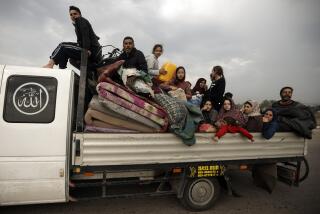Marines secure key areas in Marja in major assault on Taliban
- Share via
Reporting from Kabul, Afghanistan, and The Outskirts Of Marja, Afghanistan -- U.S. Marines seized key positions in the Taliban sanctuary of Marja on Saturday, as thousands of coalition troops picked their way through a dense tangle of homemade bombs to consolidate their hold on a swath of desert and farm territory surrounding the southern Afghan city.
U.S. and Afghan commanders reported only scattered resistance from Taliban fighters, who boasted that they were holding off the massive coalition assault, despite evidence that they were retreating -- most likely to fight another day.
Western military officials said that some insurgents had fled the town before the offensive and that others appeared to have fallen back to parts of the town not yet secured by the Marines. At least 20 insurgents were killed in the fighting, military commanders said.
Two members of NATO’s International Security Assistance Force were killed on the first full day of the offensive, meant to establish security and governance in what had been a chaotic corner of Helmand province. Their nationalities were not immediately disclosed.
Three U.S. service members were killed in an explosion elsewhere in the south Saturday, the military reported.
The Marines, who pushed into the Helmand River Valley seven months ago, had described Marja as the last main Taliban stronghold in their theater of operations.
The offensive is the first major operation involving U.S. forces since President Obama decided late last year to deploy 30,000 more troops to Afghanistan in a bid to turn the tide of the war before an expected American drawdown next year. On Saturday, the White House said the president was receiving updates through the Situation Room and would be speaking Sunday to Army Gen. Stanley A. McChrystal, commander of Western forces in Afghanistan.
About 5,000 Marines are spearheading the Marja offensive, but a total of about 15,000 coalition troops are involved in combat and support roles, including British and U.S. Army units that pushed in from the northeast, linking up with the Marines to encircle the town.
The offensive began with the thunder of helicopters filling the dark sky. More than 60 took part in what British Maj. Gen. Nick Carter, commander of NATO forces in southern Afghanistan, described as a “successful insertion” by air of thousands of coalition and Afghan troops into the town and surrounding farmlands.
The ground advance into the main population center was slower, delayed by the painstaking task of clearing away one of the thickest layers of improvised explosive devices, or IEDs, that Western commanders had yet encountered.
Homemade bombs, planted by insurgents on roads, in culverts and in open terrain, are the No. 1 killer of Western troops in Afghanistan. Throughout the day, the boom of detonations echoed through the streets as bomb disposal teams disabled one device after another.
The network of canals ringing the town -- built decades ago as part of a U.S.-sponsored agricultural development program -- was used by insurgents as makeshift fortification, with the defenders seeding the banks with bombs and trying to flood a main waterway. The Marines laid down metal bridges to cross the canals.
Several thousand civilians have fled, with the exodus continuing even amid the fighting. The North Atlantic Treaty Organization had urged noncombatants to stay in their homes once the battle began, rather than risk their safety on the roads, but some families risked encounters with roadside bombs and Taliban checkpoints to get clear.
“Our home and orchards were destroyed in the last offensive, and we are worried that they might be destroyed again,” said Marja farmer Abdul Hadi, who took shelter with his family in the provincial capital of Lashkar Gah. But he expressed support for the offensive. “Marja was on fire, and we want it pulled from the flames,” he said.
The performance of Afghan forces is being closely watched as an indicator of their eventual ability to shoulder security responsibilities so foreign troops can leave Afghanistan. In previous offensives in Helmand, the Afghan army’s performance was spotty.
The Marja operation is code-named Moshtarak -- “Together” in the Dari language, and apparently meant to emphasize the partnership between Afghan and coalition troops.
The commander of Afghan forces, Gen. Sher Mohammad Zazai, said his troops had helped uncover Taliban weapons caches throughout the day, seizing arms that included heavy machine guns and rocket-propelled grenades, and carried out house searches that cultural sensitivities dictate be done by Afghan troops rather than foreigners.
President Hamid Karzai, who gave his approval to the offensive only hours before its start, issued a short statement calling on the assault force to exercise “absolute caution to avoid harming civilians.” Karzai also made a direct appeal to insurgents in Marja to lay down their weapons.
Taliban spokesman Qari Yousaf Ahmadi, reached by telephone, shrugged off Karzai’s appeal, and insisted the insurgents were holding off the coalition force.
But there were signs that many Taliban fighters, including some commanders, had held to their usual practice of melting away in the face of a full-on confrontation with Western forces. Often, they regroup and carry out harassing attacks.
Gulab Mangal, governor of Helmand province, told reporters that the “first phase of the operation is very successful,” but suggested that bringing a genuine sense of safety to townspeople would take far longer.
“There is so much that we need: roads, hospitals,” said a Marja tribal elder, Ali Shah Khan Mazlomyar. “What we need is security -- real, permanent security.”
More to Read
Sign up for Essential California
The most important California stories and recommendations in your inbox every morning.
You may occasionally receive promotional content from the Los Angeles Times.










